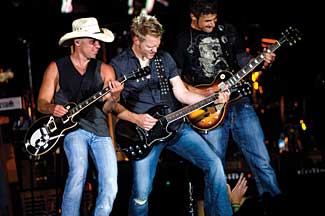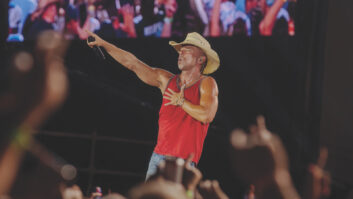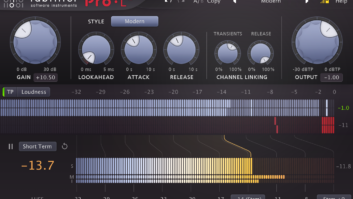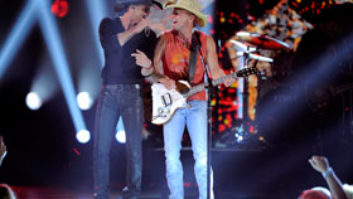
Kenny Chesney performing live.
When you’re the reigning Academy of Country Music Entertainer of the Year, it’s only natural that you’ll be selling out stadium shows. And while this touring success is a great boon for the artist, and the industry in general, getting a great amplified sound out of a venue that was originally designed for sporting events can be a chore for the sound crew. But Kenny Chesney’s crew — which comprises front-of-house engineer Bryan Vasquez, vocal monitor engineer Phil Robinson, band monitor engineer Bryan “Opie” Baxley and systems engineer Matt Naylor — are up to the challenge, drawing on their longtime experience working with this artist.
Vasquez and Robinson admit that they wouldn’t be inclined to go hear a show at a stadium. Vasquez explains, “Since football stadiums are built for sporting events, they’re designed to amplify the crowd noise [from the stands] and project it down to the field. When you get a loud band and a loud P.A. setup in the middle of that, the sound gets focused right back down onto the field.” But would this crew rather be playing only sheds instead of mixing it up with the stadium gigs? No, says Vasquez, “That would be boring!”
As the tour is self-contained, carrying everything they need and renting only some rigging when shows are too close to allow time for road transport, the crew is fully equipped to meet the acoustical challenges inherent in stadiums. They rig up Electro-Voice X-Line speakers for the mains and XLCs for sidefills, and Dynacord VL262s frontfills, all powered by Electro-Voice amps.
Systems engineer Naylor starts his day measuring the room, using range-finding binoculars to gauge the depth and height of the fills. He then runs that data through Electro-Voice’s LAPS (Line Array Prediction Software) to set the angles and curve of the arrays. “With stadiums, it’s basically a flat, tight pack for a long throw,” Naylor explains. The next step is employing Smaart to set the delays between the arrays, working with five different zones: the mains, 240-watt sides, 270W sides, front-fills and subs.
With the P.A. in place, Naylor receives a stereo matrix from FOH that he then customizes for each array. He sends a stereo mix to the front-fills, while he sums the mix to mono for the side-fills. The center fill is a heavy vocal mix with just a bit of the band beneath it, aimed to balance the band’s stage sound hitting the area right in front of the stage.
In the FOH booth, Vasquez mans a Midas XL8 and does not require outboard gear. The only rack he sets up contains a hard disk recorder and a CD player. They don’t track every show in its entirety, but Chesney advises him to be ready to hit Record if something interesting comes up. Vasquez says, “Sometimes Kenny will stray off the set list and do what we call a ‘keg-in-the-closet set.’ That’s where he’ll do a bunch of cover tunes and they could pull anything out. I’m always set up to record in case something special happens, guest stars might show up — there’s no tellin’!” Robinson adds, “We’ve got a good idea what song we’re starting with, and from that point on it could be anything.”
Up onstage, most of the mics are from Audio-Technica, which has an endorsement deal with Chesney. “They’re generous with their endorsement,” says Robinson. “They give us whatever we need, and if they don’t have something that fits the bill, we can use whatever else we want.” For vocals, Chesney sings through the Audio-Technica Artist Elite Series 5400; backing vocals are mostly Audio-Technica models and a couple of Shure Beta 58s. All the instrument wireless and drum miking are Audio-Technica: the dual-element AE2500 (kick), ATM 650 (snares), AE3000s (toms) and AT4050s (overheads).
“[The] Audio-Technicas worked out well,” Robinson continues. “They’ve been super-cool with helping us design stuff, helping us build things that don’t exist yet, even design capsules that sound better. And wireless transmitters — we wanted to use one receiver with multiple packs, and they helped us design a system where you just hit a button, and it changes the frequency inside the receiver, so we have guitars A, B and C on buttons on the receiver.”

From left: systems engineer Matt Naylor, front-of-house engineer Bryan Vasquez and vocal monitor engineer Phil Robinson
Photos: Paul Natkin
The show includes a four-man horn section (saxophonist Jim Horn, trombonist Chris Dunn, and trumpeters Steve Herman and Scott Dukaj), all using Audio-Technica’s ATM350cW clip-on high-SPL mics. As the horns are on- and offstage several times during the show, their wireless packs have a built-in Mute switch.
In addition to drums, Sean Paddock also plays a cajone. Miking the instrument turned into an experiment in placement, but Vasquez eventually found a spot for an Audio-Technica 4055 to pick up the low end where it wouldn’t get too much of the slap from the top. A Shure SM57 delivers the high end. Percussionist Drummy Zeb plays behind a Plexiglas screen to shield his sound. Vasquez mikes the percussion with Electro-Voice 468s and Shure KSM 27s and SM57s.
Fiddle player Nick Hoffman runs his Zeta electric fiddle direct through an Avalon U5 preamp into a Fishman Aura Acoustic Imaging Blender to replicate a miked acoustic sound. It is then routed through TC Electronic’s G-Major for effects processing, adding chorus and some reverb before sending out a stereo signal.
Welcome to Stage-Left
Behind the scenes, both Robinson and Baxley work on Midas Pro 6 consoles. Setting up Chesney’s vocal mix, Robinson dials up his vocal most prominently, with reverb, and backing vocals slightly under him. He prefers the band at only about half his level. Robinson is mainly cueing instrument solos that Chesney needs, pushing them at the right time and the right amount not to block his vocal. He cups the mic, putting his hand around the diaphragm, and the engineer has to tell Chesney not to do it without “pissing him off. Sometimes he listens, sometimes he decides not to listen,” Robinson says.
The band’s monitoring is all but invisible. All except the horn players wear Sennheiser in-ear monitors. Robinson explains, “When horn players play, they’re vibrating their lips and their heads, so when [the sound] gets back to their ears, it’s out of phase. I haven’t met a horn player yet that uses ears.” So the horn section has wedges, and the only other wedges onstage are one for the drummer and one for the bass player’s sub.
After some debate, the crew has decided to forego using monitor sidefills because, while they may cure some problems, they just cause others. They have the potential to create the need for more wedges to boost each player’s own mix, as well as a long list of cues for the engineers to manage. Of course, in-ears can create some challenges, too. For example, Chesney sometimes will pull out an earphone so he can hear the crowd. “He’ll have the mic right beside it,” Robinson says, “so he’ll get the really high-end feedback that you can barely hear, that makes your eyeballs hurt. He can’t hear why it’s making that sound, and I can’t get my eyes uncrossed long enough to tell him.”
Nonetheless, getting tied up with a lot of speakers onstage complicates things both from an engineering standpoint and aesthetically. Chesney is adamant about having an uncluttered, clean look onstage, so the ultimate solution has been to keep things in the in-ear realm as much as possible.
When you go to a Chesney concert, don’t bother watching the stage when showtime arrives. Kenny gets lifted up from the FOH booth on a sort of trapeze chair, performing his first number as he dangles above the heads and reaching hands of his faithful followers. During his airborne approach to the stage, he’s far enough from the P.A. that it’s out of time with his in-ears. “We couldn’t get his monitor loud enough to cover the P.A. and the crowd noise,” Robinson explains, “so we took this blinking light, which converts a click track to a flashing light, so he can find the downbeat and know he’s in sync with the band.” This clever workaround was so successful that Chesney now uses it throughout the set whenever he comes out onto the catwalk. “Bryan will keep moving it around so Kenny can see it from wherever he is. We’ve got a nine-dollar ‘blinky light’ taking care of a million-dollar show.”
Carolyn Maniaci (nee Engelmann), formerly an assistant editor for EM magazine, is now based in Chicago.




